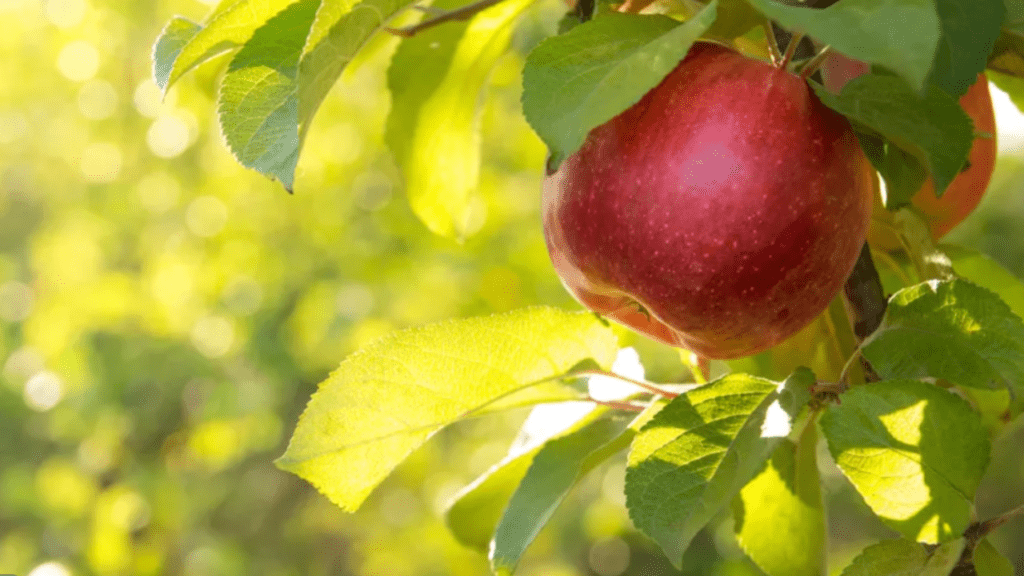
How to Identify Common Problems with Apple Tree Leaves
Apple trees are a popular and valuable addition to any garden or orchard, but they are also susceptible to a variety of issues that can affect the health and appearance of their leaves. By learning to identify and address these problems, you can ensure the continued health and productivity of your apple trees. In this article, we will discuss some of the most common issues that can affect apple tree leaves and provide guidance on how to address them effectively.
Table of Contents
ToggleUnderstanding Apple Tree Leaf Anatomy
Is essential for identifying and addressing common problems. Apple tree leaves have a distinct shape, with a broad, oval outline and serrated edges. They are typically dark green in color, but can turn yellow, brown, or develop spots or discoloration if there is an issue affecting the tree. Common problems that can affect apple tree leaves include fungal diseases such as apple scab and powdery mildew, as well as nutrient deficiencies, pest infestations, and environmental stressors. Identifying these issues early on is crucial for effective treatment and prevention. By closely observing the appearance of the leaves and understanding their anatomy, you can take proactive measures to maintain the health and vitality of your apple trees. It is important to consult with a professional arborist or horticulturist for specific guidance on identifying and addressing issues with apple tree leaves.
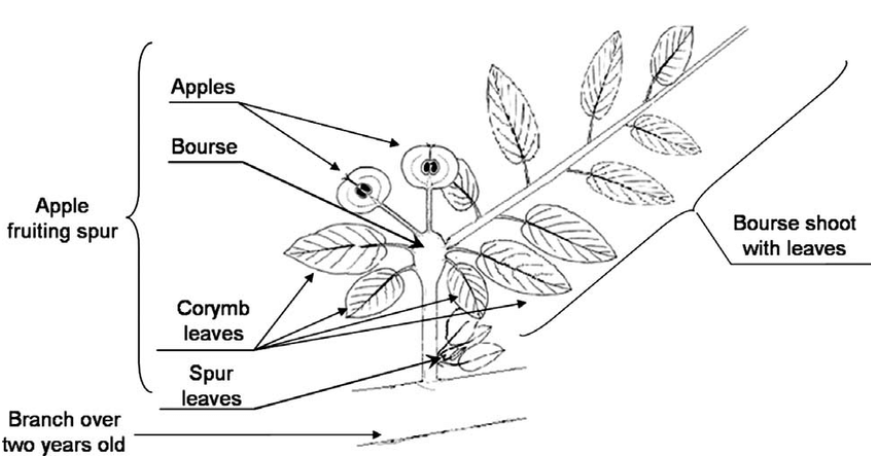
Signs of Common Apple Tree Leaf Problems
Yellowing Leaves: Discuss the causes of yellowing leaves, such as nutrient deficiencies, overwatering, or pests.
Yellowing leaves on apple trees can be a sign of various issues that need to be addressed. One common cause of yellowing leaves is nutrient deficiencies, particularly a lack of nitrogen, potassium, or magnesium. Overwatering can also lead to yellowing leaves, as it can cause root rot and prevent the tree from absorbing essential nutrients. Additionally, pests such as aphids or spider mites can suck the nutrients from the leaves, leading to discoloration.
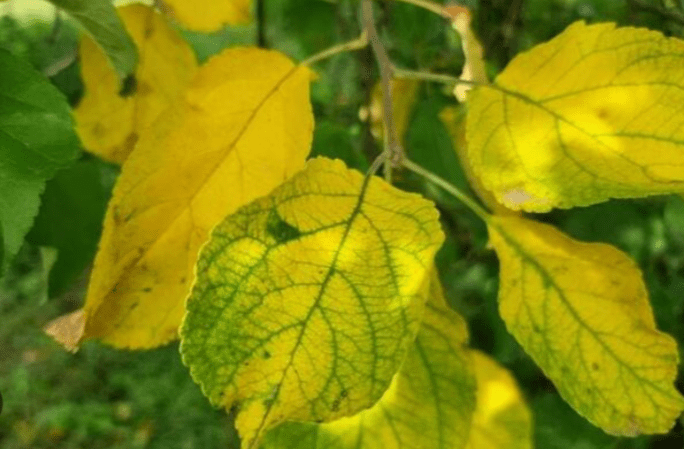
It’s important to closely monitor the health of your apple tree and address any issues with yellowing leaves promptly. Consulting with a professional arborist or horticulturist can help you identify the specific cause of the yellowing and develop a plan to address it. By maintaining the health of your apple tree’s leaves, you can ensure the overall vitality of the tree and promote healthy fruit production.
Spots on Leaves: Explain the various types of spots (black, brown, or yellow) that can appear on apple tree leaves and their potential causes, such as fungal infections or nutrient imbalances.
There are several types of spots that can appear on apple tree leaves, and they can be indicative of various issues. Black spots on leaves can be a sign of a fungal infection, such as apple scab or black rot, which can be caused by poor air circulation, high humidity, or excessive rainfall. Brown spots on leaves can also be a sign of fungal infections, such as powdery mildew or botrytis, which can thrive in humid and moist conditions. Yellow spots on leaves can be caused by nutrient imbalances, such as deficiencies in nitrogen, potassium, or magnesium. It’s important to closely monitor the health of your apple tree and address any issues with leaf spots promptly. Proper cultural practices, such as pruning, proper watering, and maintaining good air circulation, can help prevent the development of these spots. Additionally, applying fungicides or adjusting nutrient levels in the soil can help manage and prevent these issues. Consulting with a professional arborist or horticulturist can help you identify the specific cause of the spots and develop a plan to address them to maintain the overall health and productivity of your apple tree.
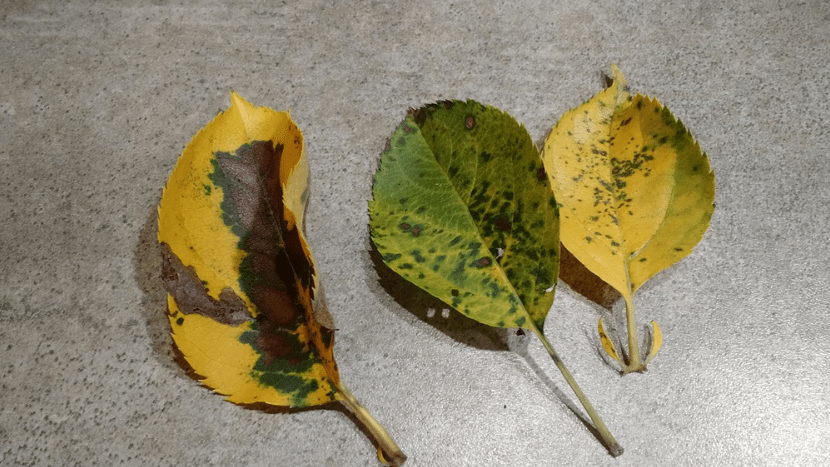
Curling Leaves: Identify the causes of leaf curling, including pest infestations, disease, or environmental stress.
Curling leaves on your plants can be a sign of various issues, including pest infestations, disease, or environmental stress. Pests such as aphids, mites, or caterpillars can cause leaves to curl as they feed on the plant. Disease, such as fungal infections or viral diseases, can also lead to leaf curling. Environmental stressors like extreme temperatures, drought, or overwatering can also cause leaves to curl. It’s important to closely examine the leaves and the overall health of the plant to determine the cause of the leaf curling. Once the cause is identified, appropriate measures can be taken to address the issue and help the plant recover. This may include using insecticides for pest control, fungicides for disease management, or adjusting environmental conditions to reduce stress on the plant. It’s important to address leaf curling promptly to prevent further damage to the plant and promote its overall health and growth.
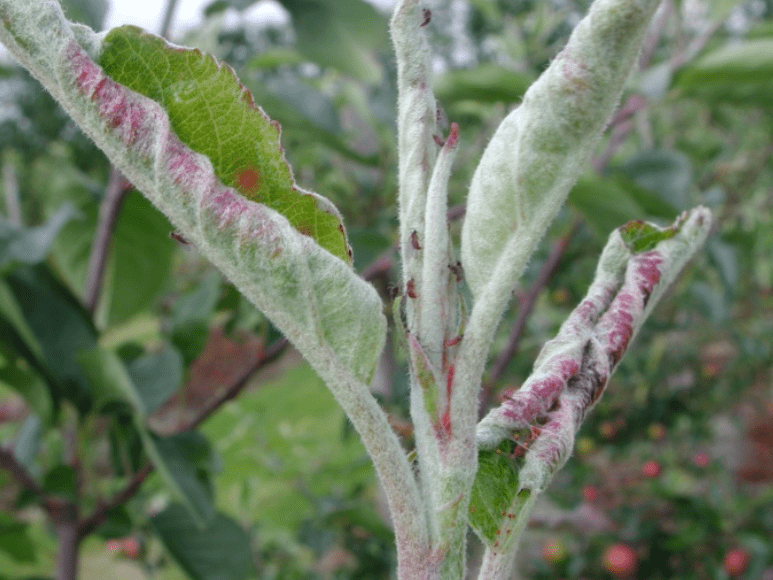
Common Apple Tree Leaf Diseases
Apple Scab: Describe apple scab, its symptoms (olive-green spots), and how it affects leaves.
Apple scab is a fungal disease that commonly affects apple trees. It is characterized by olive-green spots on the leaves, which can eventually lead to the leaves becoming distorted and falling off the tree. The disease can also affect the fruit, causing dark, scabby lesions that make the apples unappealing and can reduce their quality. Apple scab can be a serious problem for apple growers, as it can lead to reduced yields and lower-quality fruit.
The best way to prevent apple scab is through cultural practices such as maintaining good air circulation around the tree, avoiding excessive moisture on the leaves, and removing fallen leaves and fruit from the ground. Fungicides can also be used to help control the disease. It’s important to monitor apple trees for signs of apple scab and take appropriate measures to prevent its spread. By addressing the symptoms and taking preventive measures, apple growers can help protect their trees from apple scab and ensure a healthy harvest.
Powdery Mildew: Explain the signs of powdery mildew, such as white powdery spots, and how it spreads.
Powdery mildew is a common fungal disease that affects a wide range of plants, including fruits, vegetables, and ornamental plants. The signs of powdery mildew include white, powdery spots on the leaves, stems, and sometimes even the fruit of the plant. These spots can eventually cause the leaves to become distorted and fall off the plant. The disease spreads through spores that are carried by the wind, so it can easily spread from one plant to another in a garden or orchard. To prevent powdery mildew, it is important to keep the area around the plants clean and free of debris, and to provide good air circulation by spacing plants properly. Fungicides can also be used to help control the disease, but it is best to take preventive measures to avoid the spread of powdery mildew in the first place. Keeping the plants healthy and free from stress can also help prevent powdery mildew from taking hold.
Rust Diseases: Discuss rust diseases, including cedar-apple rust, and the appearance of rusty spots on leaves.
Rust diseases, such as cedar-apple rust, are common fungal infections that can affect a variety of plants, including trees, shrubs, and ornamental plants. These diseases are characterized by the appearance of rusty spots on the leaves and sometimes on the stems and fruit of the plant. The rusty spots are actually clusters of spores that can easily spread to other plants, especially during wet and humid conditions.
To prevent and control rust diseases, it is important to remove any infected plant material, such as fallen leaves or fruit, from the area. Proper pruning and spacing of plants can also help improve air circulation and reduce the spread of the disease. Fungicides can be used to treat rust diseases, but it is important to follow the instructions carefully and apply them at the right time to be effective.
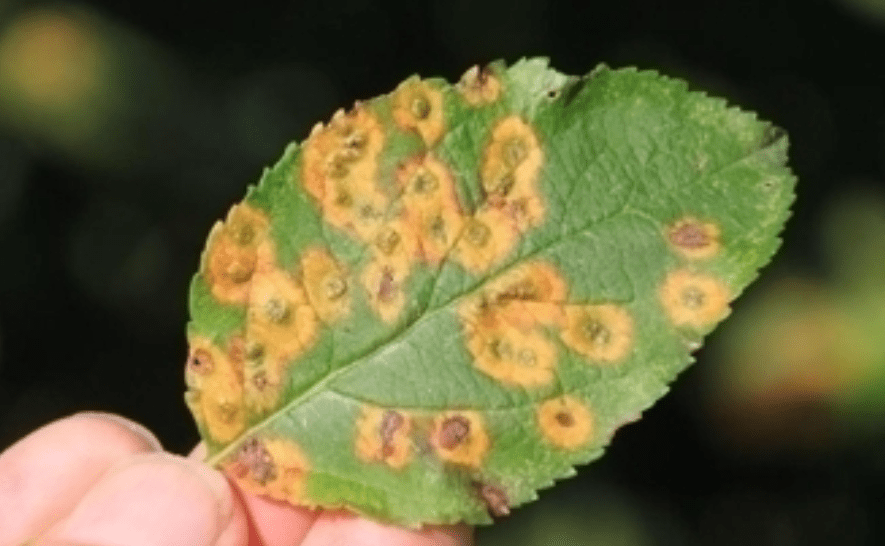
Regular inspection of your plants for any signs of rust diseases can help catch and treat the problem early before it spreads to other plants. Maintaining good overall plant health by providing proper nutrition and watering can also help prevent rust diseases from taking hold in the first place.
Pests that Affect Apple Tree Leaves
Aphids: Detail how aphids cause curling and distorted leaves, and how to spot them.
Aphids are tiny insects that can cause damage to apple tree leaves. They feed on the sap of the leaves, which can cause them to become distorted and curled. You can spot aphids by looking for small, soft-bodied insects on the underside of the leaves. They can be green, black, red, or brown in color. To control aphids, you can use insecticidal soap or neem oil, or introduce natural predators such as ladybugs or lacewings to your garden. Maintaining good overall plant health and providing proper nutrition and watering can also help prevent aphids from infesting your apple trees in the first place. Regularly inspecting your plants for any signs of aphids can help catch and treat the problem early before it causes significant damage.
Spider Mites: Explain the damage caused by spider mites, including stippling and bronzing of leaves.
Spider mites are tiny pests that can cause significant damage to plants, including apple trees. They feed on the sap of the leaves, which can result in stippling and bronzing of the leaves. Stippling appears as tiny yellow or white spots on the leaves, while bronzing causes the leaves to take on a bronze or yellowish appearance. If left untreated, spider mite infestations can lead to defoliation and stunted growth in plants. These pests can be difficult to spot as they are very small, but you can look for fine webbing on the leaves, which is a common sign of spider mite presence. To control spider mites, you can use insecticidal soaps, neem oil, or horticultural oils to suffocate and kill the pests. It’s important to regularly inspect your plants for any signs of spider mites and take action to control their population to prevent significant damage to your plants.
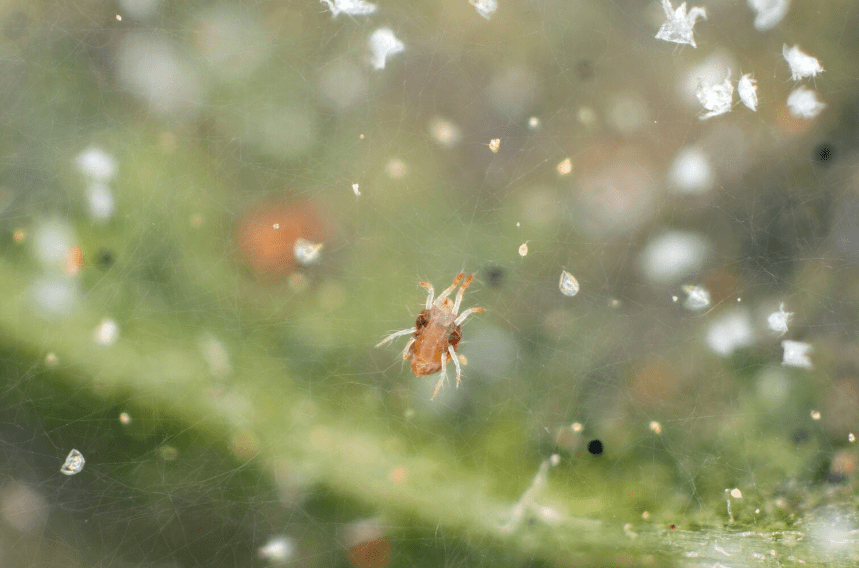
Leaf Miners: Describe the characteristic trails left by leaf miners and their impact on leaf health.
Leaf miners are tiny insect larvae that feed on the inside of leaves, creating characteristic trails as they tunnel through the leaf tissue. These trails often appear as winding, whitish or brownish lines on the surface of the leaf. While the damage caused by leaf miners is mostly aesthetic and does not typically kill the plant, heavy infestations can lead to reduced photosynthesis and overall decline in the health of the plant. The impact of leaf miners on leaf health can vary depending on the severity of the infestation and the type of plant being affected. In some cases, the damage caused by leaf miners can make plants more susceptible to other pests and diseases. It’s important to monitor for signs of leaf miner activity and take steps to manage their population in order to maintain the health and aesthetic appeal of your plants. This can include removing affected leaves, using insecticides, or encouraging natural predators of leaf miners to help control their population.
Environmental Factors Affecting Apple Tree Leaves
Water Stress: Discuss the effects of both overwatering and drought stress on apple tree leaves.
Water stress can have significant effects on apple tree leaves. Overwatering can cause the leaves to become yellow and wilted, as the roots become waterlogged and are unable to take in oxygen. On the other hand, drought stress can cause the leaves to become dry, curl up, and turn brown at the edges. Both overwatering and drought stress can lead to reduced photosynthesis and overall decline in the health of the apple tree. It is important to monitor the water levels and ensure the apple tree is receiving the appropriate amount of water to maintain healthy leaf growth. Proper irrigation and drainage are key to preventing water stress and maintaining the health of the apple tree leaves.
Sunburn and Frost Damage: Explain how extreme temperatures can lead to scorched or damaged leaves and how to prevent it.
Sunburn and frost damage can have detrimental effects on apple tree leaves. Sunburn occurs when the leaves are exposed to extreme heat and intense sunlight, causing them to become scorched, dry, and brown. Frost damage, on the other hand, occurs when the leaves are exposed to freezing temperatures, leading to discoloration, wilting, and in severe cases, total leaf loss. To prevent sunburn, it is important to provide adequate shade for the apple tree, especially during the hottest parts of the day. Planting companion plants or using shade cloth can help protect the leaves from excessive sunlight. To prevent frost damage, it is important to cover the apple tree with frost cloth or blankets during cold nights, and also ensure that the tree is properly watered and well-mulched to provide insulation and protect the roots from freezing. It is important to be proactive in protecting the leaves from extreme temperatures to maintain the health and vitality of the apple tree.
Nutrient Deficiencies: Identify common nutrient deficiencies (e.g., nitrogen, magnesium) that result in discolored or malformed leaves.
Nutrient deficiencies can have detrimental effects on apple tree leaves. Common deficiencies such as nitrogen and magnesium can result in discolored or malformed leaves. Nitrogen deficiency can cause leaves to turn yellow and stunt the growth of the tree, while magnesium deficiency can lead to interveinal chlorosis, where the tissue between the leaf veins turns yellow while the veins remain green. To prevent these deficiencies, it is important to regularly fertilize the apple tree with a balanced fertilizer that contains the necessary nutrients. Additionally, testing the soil and adjusting the pH levels can help ensure that the tree has access to the nutrients it needs. It is important to carefully monitor the health of the leaves and address any nutrient deficiencies promptly to maintain the overall health and productivity of the apple tree.
How to Diagnose Apple Tree Leaf Problems
Visual Inspection Tips: Offer tips on how to visually inspect apple tree leaves for signs of problems.
When visually inspecting apple tree leaves, it’s important to look for signs of problems that could indicate issues with the tree’s health. Check for any discoloration, spots, or unusual patterns on the leaves. Yellowing or browning of the leaves, as well as stunted growth, can indicate nutrient deficiencies or other problems. Additionally, look for any signs of pest infestation or disease, such as small holes in the leaves or powdery mildew. It’s also important to inspect the overall condition of the tree, including the branches and trunk. Regularly monitoring the health of the apple tree and addressing any issues promptly can help ensure its long-term health and productivity.
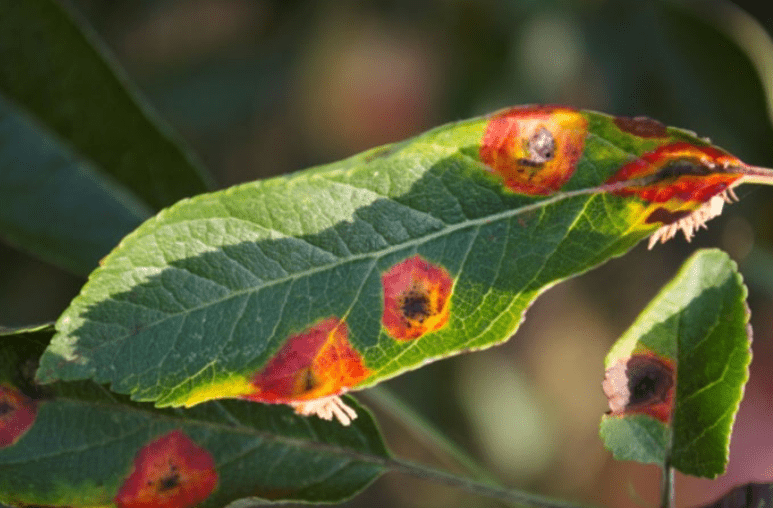
Using Diagnostic Tools: Suggest tools like soil tests or magnifying glasses to help diagnose issues.
Diagnosing apple tree leaf problems is crucial for maintaining the health and productivity of your apple trees. Visual inspection is a key way to identify any issues with the leaves. Look for discoloration, spots, or unusual patterns on the leaves, as well as signs of pest infestation or disease. Additionally, consider using diagnostic tools such as soil tests to check for nutrient deficiencies and magnifying glasses to closely examine any signs of pest infestation. These tools can help you accurately diagnose any issues and take the necessary steps to address them. Regular monitoring and prompt action are essential for ensuring the long-term health of your apple trees.
Consulting Expert Resources: Recommend when to consult a local extension office or arborist for expert diagnosis.
Diagnosing apple tree leaf problems is crucial for maintaining the health and productivity of your apple trees. Visual inspection is a key way to identify any issues with the leaves. Look for discoloration, spots, or unusual patterns on the leaves, as well as signs of pest infestation or disease. Additionally, consider using diagnostic tools such as soil tests to check for nutrient deficiencies and magnifying glasses to closely examine any signs of pest infestation. These tools can help you accurately diagnose any issues and take the necessary steps to address them. Regular monitoring and prompt action are essential for ensuring the long-term health of your apple trees. When facing more complex or persistent issues, it is recommended to consult a local extension office or arborist for expert diagnosis and guidance. Their expertise and resources can help you effectively address any problems and ensure the continued health and vitality of your apple trees.
Seasonal Care for Apple Tree Leaves
Visual inspection is a key way to identify any issues with the leaves of your apple tree. Look for discoloration, spots, or unusual patterns on the leaves, as well as signs of pest infestation or disease. Additionally, consider using diagnostic tools such as soil tests to check for nutrient deficiencies and magnifying glasses to closely examine any signs of pest infestation. These tools can help you accurately diagnose any issues and take the necessary steps to address them.
Regular monitoring and prompt action are essential for ensuring the long-term health of your apple trees. When facing more complex or persistent issues, it is recommended to consult a local extension office or arborist for expert diagnosis and guidance. Their expertise and resources can help you effectively address any problems and ensure the continued health and vitality of your apple trees. By taking proper care of your apple tree leaves, you can help your tree thrive and produce delicious, healthy fruit.
Conclusion
In conclusion, it’s important to regularly inspect the leaves of your apple trees for any signs of discoloration, spots, or unusual growth. By identifying these common problems early on, you can take the necessary steps to address them and ensure the overall health and productivity of your apple trees. Whether it’s a nutrient deficiency, pest infestation, or disease, being proactive in identifying and addressing issues with your apple tree leaves can help you maintain a thriving orchard.
Frequently asked questions And Answer
Some common problems with apple tree leaves include discoloration, spots, holes, curling, or wilting.
Discoloration of apple tree leaves can be caused by nutrient deficiencies, pests, diseases, or environmental stress.
Look for signs of powdery mildew, apple scab, or cedar apple rust, which are common diseases that affect apple tree leaves. These may present as spots, discoloration, or unusual growth on the leaves.
Pests such as aphids, mites, caterpillars, and apple maggots can cause damage to apple tree leaves by feeding on them or laying eggs on them.
If you notice any issues with your apple tree leaves, it’s important to properly identify the problem and take appropriate action. This may involve pruning affected branches, applying pest control measures, or adjusting the tree’s nutrient levels.
Regularly inspecting your apple tree for signs of pests or diseases, providing proper nutrition and care, and maintaining good air circulation around the tree can help prevent problems with the leaves.
Some natural remedies for apple tree leaf problems include using neem oil for pest control, applying compost or organic fertilizers for nutrient deficiencies, and using fungicidal sprays for diseases.
If you are unsure of the cause of the problems with your apple tree leaves or if the issues persist despite your efforts, it’s best to seek professional help from a certified arborist or horticulturist.
